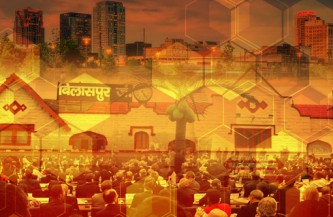SWARAJYA: MAKING OF A COMPOSITE NATION STATE

Multi-dimensional justice, can be ensured by efficient governance. Will a power superior in military strength, organisational expertise, general innovative edge over the people they rule be able to ensure progress over the autochthonous people of the land? Will a foreign but expert government, do it plausibly? Yes indeed, was the view held by colonising nations, something that was penned down by Rudyard Kipling in his poem,
The White Man’s burden, a poem he wrote as his contribution to the celebration of Queen Victoria’s Diamond Jubilee in 1897, but he repurposed this literary arsenal of his to exhort the so called civilised American people to conquer and rule Philippines. Historian Niall Fergusson in his book Civilization: The West and the Rest starts from the premise that western dominance has been a good thing. The west’s ascendency, he argues, is based on six attributes that he labels its “killer apps”: competition, science, democracy, medicine, consumerism and work ethic. Well the Grand Old man of India Dadabhai Naoroji has with utmost sagacity explained us the drain of wealth that happened during British colonial rule in India. Well how can western dominance be a good thing if it financially emaciated us, and culturally subjugated us? Was geography and not biologically determined intellectual superiority that gave Europe an edge before the age of exploration and industrialization? Well Historian Kenneth Pomeranz mentions in his book the great divergence that Europe’s nineteenth-century divergence from the Old World owes much to the fortunate location of coal, which substituted for timber, which allowed growth of energy efficient industries. All and all we can reach to a conclusion that colonial dominance, may it be disguised as trusteeship, benevolent dictatorship or what not can not ensure justice to the colonised. the power asymmetry is enough to create a chasm of hatred and a generalised believe in the rulers superiority inducing a intellectually debilitating inferiority complex amongst the colonised for them to deal with.
The idea of India as a civilisational state different from Western Westphalian states like Indian model of secularism is different from that of the West, has been there for a long time. This unity in diversity was reflected in the letter Chhatrapati Shivaji wrote to Aurangzeb, but he ensured that his openness to engage with diverse views is not perceived as his weakness, for he was a realist in modern terms, and believed that diplomacy can not be an alternative to hard power at best it can supplement it. The proto-nationalist aspirations of the Maratha King were beyond the age he was living in. The idea of leaving Maharashtra for a Southern Campaign or Dakshin Digvijay vindicates the absence of aspiration of creating just a regional state what Shivaji planned was bigger, he planned to overthrow the rule of the Mughal emperor of Delhi it may have at that moment appeared rather fantastical but soon Marathas reached the gates of Delhi and moved on to Lahore and Peshawar, it was indeed Shivaji’s vision that guided the later Marathas to the idea of an independent India from Attock to Cuttack from Thanjavur to Peshawar.
After being ruled over the years by kings who claimed their superiority on the grounds of their association with the family of Timur the Central Asian conquerer or the Shah of Iran in the case of Deccan sultanates, there was a rise of an aspiration for a Hindavi Swarajya or self rule. Shivaji was aware about European colonial aspirations hence he established a navy for what was gained on the ground shouldn’t be lost through the sea.
The contribution of Mahadji Scindia in working towards expanding and protecting the Hindavi Swarajya was really important, that too after the debacle in Panipat, where the grand project of Swaraj from Attock to Cuttack was majorly decimated. He realised significantly what Shivaji had dreamt of to create a united India for that he went from Lahore to Bharuch, to Allahabad to Cuttack conquering uniting the fragmented polity of India of those times. He defeated the British in Wadgaon and several other places ensuring that the fear of a Scindia retaliation to any British misadventure against Swaraj was established. This is what several intellectuals have to say about him “Mahadji Scindia, who was one of the greatest soldiers and cleverest statesman ever produced by India, greatly distinguished himself at the battle of Panipat in 1761; and taught by that disaster, he disciplined and strongly organized his army and in this way, though nominally still a servant of the Peshwa, he became really the ruler of Hindustan.” As per Roper Lethbridge, Member of Parliament UK in “The Golden Book of India”. “ Mahadji Scindia clearly understood the changing nature of Anglo-Maratha war. He realised that the main aim of the British is to subjugate Maratha Territory and be the masters of Western Coast. Mahadji tried to invite Bhonsle of Nagpur to attack Bengal( along with Mahadji Scindia’s army) . Had Mudhoji Bhonsle responded to this idea then there was every chance of forcing Calcutta Government( British EIC) into submission. Mahadji was the most powerful among Indian chiefs who championed the cause of India’s Self-Rule.” As mentioned by Sonali Pednekar and Mohsina Mukdam in History of Marathas. Let’s try to understand how the Hindavi Swarajya that Chhatrapati Shivaji was so passionate about became an inspiration to makers of modern India, taking various forms from Swarajya to Hind Swaraj to Purna Swaraj and so on. Intellectual, author and journalist Sakharam Ganesh Deuskar was one of the principal proponents of Indian Renaissance. Born and raised in Bengali environment of Marathi origin, Deuskar worked as a connecting link between the Renaissance of Maharashtra and Bengal.
One of the works of Deuskar that most influenced the Enlightenment of the Renaissance period was the work ‘Deshar Katha’ published in 1904. Its Hindi-translation was named ‘Desh Ki Baat’ (1910). Sakharam Deoskar composed this historical piece mainly on the basis of which William Digby, Dadabhai Naoroji and Ramesh Chandra Dutt wrote about the foreign exploitation of the Indian economy. This work of Deuskar portraying the ruin of the industries of India is a document of the downfall of the fallen Indian under the jugglery and exploitation in the chains of British imperialism.
Deuskar was a friend of Sri Aurobindo, who was also an early purna swarajist, an advocate of India’s complete independence. In a few years, with the struggle for freedom acquiring momentum especially because of Lord Curzon’s partition of Bengal in 1905, swaraj became the most evocative and popular of indigenous words for political freedom, whether total or partial, within the British Empire. We mentioned the Grand Old man of India Dadabhai Naoroji in the beginning, he carried forward the idea of Hindavi Swarajya in the form of Swaraj In 1906, Dadabhai Naoroji (1825-1917) declared swaraj, or Indian self-government, as the goal of the Indian National Congress. Naoroji developed the idea of swaraj during his five decades-long political and nationalist career, which included groundbreaking economic research on Indian poverty, engagement with emancipatory movements around the world, and becoming the first-ever Asian elected to the British Parliament.
Naoroji’s swaraj, as we will see, was global in nature. It evolved from contact with European liberalism and socialism and, at the same time, had a significant influence on the growth of global anti-colonialism and antiracism. The anti-colonialism and opposition to foreign occupation and tyranny were the connecting link with the Shivaji tradition. Tilak was one of the prime architects of modern India and probably the strongest advocates of swaraj (self rule). He was conferred upon the title, “Lokmanya” (beloved leader) by his followers. He gave the slogan of “Swaraj is my birthright and I will have it”.
Tilak was influenced by Ganesh Utsav in Gwalior state which itself was a proponent of Hindavi Swarajya during time of Shreenath Mahadji Scindia who not just conquered Lahore, but got British to surrender the port town of Bharuch in Gujarat to him , he conquered the fort of Allahabad but was one of the few Indian rulers who dreamed of a united India. A year into the Non-Cooperation Movement, Mahatma Gandhi announced the Tilak Swaraj Fund. The Fund, a homage to Bal Gangadhar Tilak on his first death anniversary, aimed at collecting Rs 1 crore to aid India’s freedom struggle and resistance to the British rule. A massive amount at the time, the sceptical were proved wrong when the money came in by the set deadline of June 30. Of the collected amount, Rs 37.5 lakh was donated by Bombay, which led him to refer to the city as “Bombay the Beautiful”. Mahatma Gandhi also wrote his own book on Swaraj Hind Swaraj in 1909, focusing on multidimensional nature of Swaraj
The journey of Hindavi Swarajya has been a long one it attained substantial success when India became independent but it continues even today what the rise of Maharashtra dharma taught will only be fulfilled when we create a society where the poor feels that he/she also has an opportunity for self growth and if it doesn’t so happen due to difficulties then the state is there to support him that is the Swaraj Shivaji dreamt of, Mahadji Shinde worked for and Malhar Rao Holkar struggled for.
The Author of this blog is Shri Arunansh B. Goswami (Historian & Advocate)






Total Comments - 0